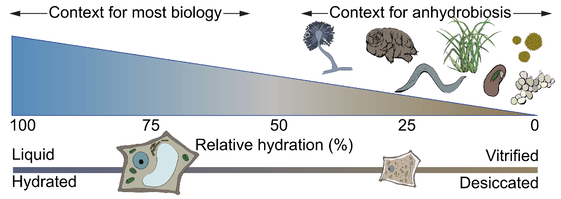WALII RESEARCH
Our planet’s surface and all life forms on it are composed mostly of water. Yet, survival at extremely low water content, anhydrobiosis, is essential for organisms across all kingdoms of life. The Water and Life Interface Institute (WALII) will study how life interacts with water from the molecular to the organismal level across plants, fungi, and animals.
|

Concepts and tools in life sciences have been made primarily in the context of fully hydrated systems. WALII will study the interaction of life and water across timescales and hydration states in diverse organisms, using four intertwined themes. The multi-scale, transdisciplinary studies of anhydrobiosis at WALII aim to ignite a transformative new field of solid-state biology, focused first on modeling function and dysfunction of biomolecules, cells, tissues, and organisms under desiccation stress. New methods and approaches will be essential, including better protocols for seedbank preservation and stabilizing plant sexual reproduction, better water-resistant materials and water-retention strategies, and sensitive in vivo tools for sensing and manipulating cellular responses to desiccation.
Theme 1: Surviving the solid state
Desiccation presents massive changes to the physical and chemical cellular environment. Removing water concentrates cellular constituents until these solidify into a vitrified material (a glass). Glasses maintain structural heterogeneity and slow physical and biochemical change, making them natural promoters of desiccation tolerance. Indeed, vitrification is considered necessary for desiccation tolerance. However, the process of vitrification presents major physical challenges to biological systems, including molecular crowding, high osmotic pressure, and orders of magnitude increase in viscosity. These changes can irreversibly perturb biomolecular function, such that vitrification, while necessary, is not sufficient for desiccation tolerance. What distinguishes the vitrification process in desiccation tolerant versus sensitive systems is not currently known. We propose to uncover the molecular and cellular determinants that enable desiccation tolerant organisms to survive vitrification.
Theme 2: Rehydration and recovery from desiccation
The structural changes associated with removing water from cells are reversed upon rehydration, and desiccation tolerant cells regain vital functions. In contrast, desiccation sensitive cells die. Cell viability assays do not reveal how close desiccation sensitive systems come to full repair and metabolic competency. A more detailed view of the recovery process is required to assess the efficacy of protection mechanisms and bioengineered molecules. The road to recovery will be explored quantitatively in two systems: desiccation sensitive immature Arabidopsis embryos exposed to different periods of desiccation-tolerance-inducing conditions and diverse desiccation tolerant organisms exposed to relative humidities that bring them out of desiccation but not full recovery. We hypothesize that: a) desiccation-tolerant and sensitive organisms will differ in their dynamics of metabolic recovery; and b) the quantitative differences in genetic and metabolic activities that occur during the recovery from desiccation will be key in promoting desiccation tolerance.
Theme 3: Molecular engineering
We aim to uncover design principles that underlie desiccation protection and water responsiveness by intrinsically disordered proteins in isolation and in biomolecular condensates. An integrated understanding of desiccation tolerance requires a molecular model of how the core cellular components that counteract desiccation work. Intrinsically disordered proteins and protein regions (IDPs/IDRs) have emerged as one such component. IDPs lack a fixed 3D structure; instead, they exist as an ensemble of conformations. During desiccation, these structurally plastic proteins can chaperone other biomolecules, form gelled or vitrified states, and protect membranes from rupture, as shown previously by our team members and others. IDPs can also form biomolecular condensates, which we recently discovered can play key roles during rehydration as water sensors (FLOE1). Finally, IDPs can act as intracellular sensors of physicochemical state (crowding, salt, pH, etc.). Although IDPs have conformational flexibility, they still obey sequence-encoded chemical rules that determine their influence on, and response to, changes in water availability. A deep understanding of these rules is critical to developing an integrative understanding of water-responsiveness in biology.
Theme 4: evolutionary dynamics of desiccation tolerance
Desiccation tolerance evolved recurrently across the tree of life, which provides an excellent system to study complex, emergent biological phenotypes. This theme will explore the micro- and macroevolutionary forces shaping the evolution of desiccation tolerance across eukaryotes. Together, these experiments will integrate datasets and approaches across diverse sub-disciplines of biology to identify emergent patterns underlying desiccation tolerance.













